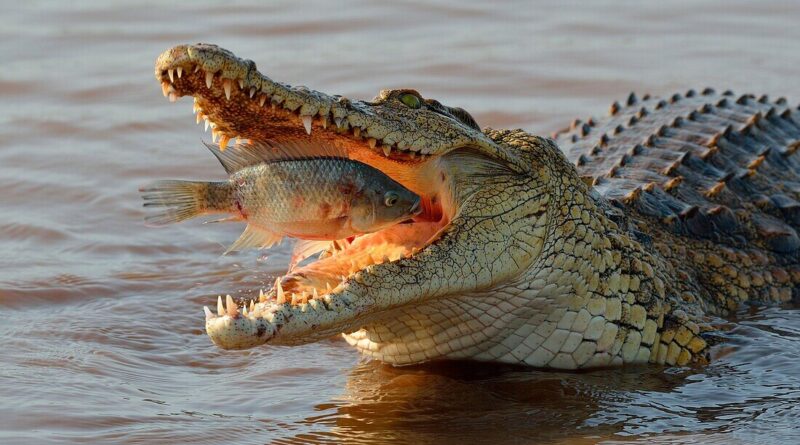Nile Crocodile Fishing Techniques Mastering the Aquatic Hunt
Nile Crocodile Fishing Techniques Mastering the Aquatic Hunt The Nile crocodile (Crocodylus niloticus) is one of Africa’s most formidable predators. Found in rivers, lakes, and marshlands across the continent, this apex predator is known for its versatility and intelligence in hunting. Although Nile crocodiles consume a wide variety of prey, fish make up a significant part of their diet, especially for smaller crocodiles and juveniles. Understanding their fishing techniques provides valuable insights into their role within the ecosystem and highlights their evolutionary adaptations for aquatic hunting.
Evolutionary Adaptations for Fishing
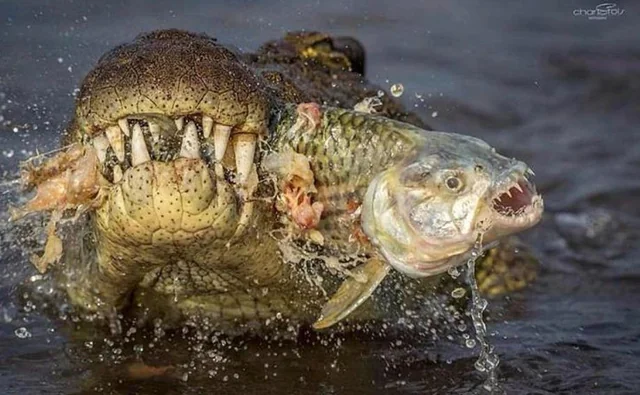
Nile crocodiles have evolved an impressive array of adaptations that make them efficient hunters in the water. Their sensory abilities play a vital role in detecting fish even in murky waters. Equipped with excellent night vision, crocodiles can hunt in low-light conditions when fish are more active. Their sense of smell is also acute, helping them locate prey even before it’s within sight.
Here’s a table summarizing the key Nile crocodile fishing techniques, their descriptions, and their effectiveness factors:
| Fishing Technique | Description | Effectiveness Factors |
|---|---|---|
| Ambush Hunting | Crocodiles remain still, camouflaged near riverbanks, waiting for fish to swim by. | Works best in murky or shallow waters where fish cannot detect the crocodile. |
| Group Hunting | Multiple crocodiles work together to corral fish into shallow areas, making them easier to catch. | More effective with large schools of fish and cooperative crocodiles. |
| Surface Snap Technique | Crocodiles quickly snap at fish near the water’s surface, using speed and surprise. | Effective in calm waters with fish swimming close to the surface. |
| Using Tidal Flow and Current | Crocodiles position themselves in strong currents, allowing the water to bring fish to them. | Works best in rivers or during tidal movements, where fish are funneled naturally. |
| Diving and Pursuit | Crocodiles chase fish underwater using quick bursts of speed. | Useful in clearer waters or when fish are spotted at a distance. |
One of the Nile crocodile’s most well-known hunting strategies is ambush predation. They can remain motionless for hours, blending into their environment, waiting for the perfect moment to strike. Their jaws, with one of the strongest bite forces in the animal kingdom, allow them to capture and immobilize fish instantly. In the water, Nile crocodiles are agile swimmers, using their powerful tails to propel themselves with bursts of speed when chasing prey.
Additionally, group hunting is a tactic often employed by Nile crocodiles, showcasing their intelligence and cooperation. By working together, they are able to herd fish into confined spaces, making it easier to capture large numbers of prey.
Fishing Techniques of Nile Crocodiles
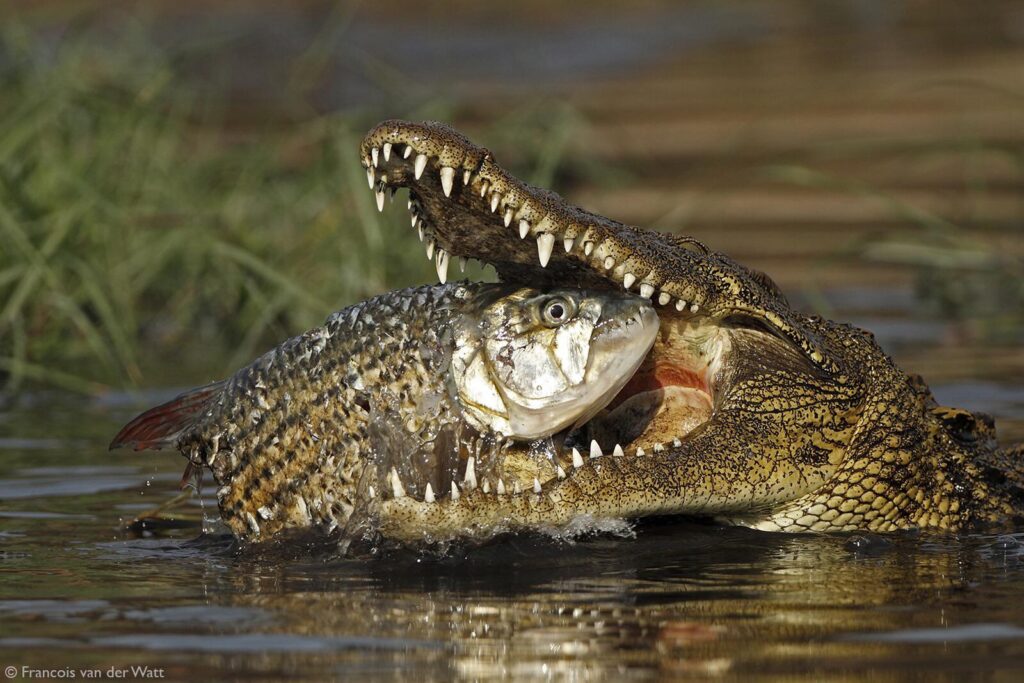
Nile crocodiles employ a variety of fishing techniques, each adapted to specific situations and prey availability:
- Ambush Hunting:
One of the most common methods Nile crocodiles use is ambush hunting. They position themselves near riverbanks, submerged logs, or in shallow waters where fish frequently swim. Remaining still and camouflaged, the crocodile waits for the fish to come close before making a sudden attack. This strategy relies on the element of surprise and quick reflexes, allowing the crocodile to catch fish unaware. - Group Hunting:
While often seen as solitary hunters, Nile crocodiles sometimes cooperate to hunt fish more effectively. In shallow waters, groups of crocodiles may drive schools of fish into smaller, confined areas, where it becomes easier for the crocodiles to snap at their prey. This technique increases their success rate, especially when dealing with larger numbers of fish. - Surface Snap Technique:
When hunting near the water’s surface, crocodiles often use a snapping technique, where they quickly break the water’s surface with their jaws to capture unsuspecting fish. The speed and force of their snap create a powerful strike, making it difficult for fish to escape once within range. - Using Tidal Flow and Current:
Another method employed by Nile crocodiles is positioning themselves in areas with strong water currents or tidal flows, where fish are naturally funneled downstream. By taking advantage of these natural movements, the crocodile conserves energy while increasing its chances of catching fish that are already being swept toward them by the current. - Diving and Pursuit:
While primarily ambush hunters, Nile crocodiles are capable of actively pursuing fish underwater when necessary. They use their strong tails to propel themselves through the water at surprising speeds, chasing fish and using quick directional changes to outmaneuver their prey. Their ability to hold their breath for extended periods allows them to remain submerged while stalking fish from below.
Factors Influencing Hunting Success
Several factors influence the success of Nile crocodiles’ fishing efforts:
- Water clarity: In clearer waters, crocodiles have a visual advantage, making it easier to spot and track fish. In murkier conditions, they rely more on other senses, such as detecting movement and vibrations in the water.
- Fish availability: The success of a crocodile’s hunt is also tied to the availability of fish in its habitat. During certain seasons, fish migrate or spawn in large numbers, offering a bounty of prey. At other times, scarcity may force crocodiles to expand their hunting grounds or target different species.
- Crocodile’s size and age: Juvenile crocodiles often rely more on smaller fish as a staple of their diet, using simpler techniques like surface snapping or quick chases. Larger crocodiles, which have more hunting options, may employ more complex strategies, including ambush and group hunting.
- Competition with other predators: Nile crocodiles often share their habitat with other fish-eating animals such as birds, hippos, or even humans. Competition for food can influence the frequency and timing of their fishing efforts.
Comparison with Other Crocodile Species’ Fishing Techniques
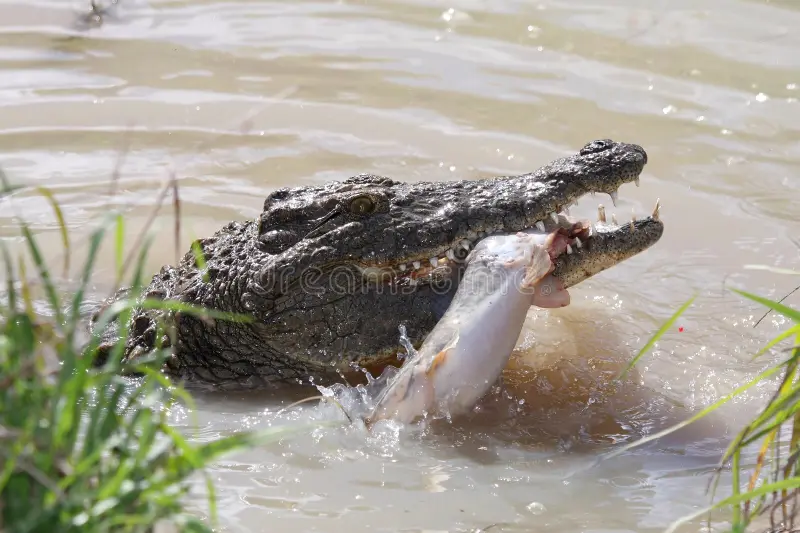
While the Nile crocodile has honed specific techniques for hunting in African rivers and lakes, its methods can be compared to other species like the Saltwater crocodile (Crocodylus porosus) or the American crocodile (Crocodylus acutus). For instance, the Saltwater crocodile, found in coastal and estuarine environments, may rely more on tidal changes and brackish water hunting. Similarly, the American crocodile, which inhabits a mix of freshwater and saltwater environments, often employs different strategies based on its habitat.
Each species has adapted to its unique environment, but many basic hunting principles remain similar—ambush, patience, and using the natural flow of water to their advantage.
Role of Fishing Techniques in Ecosystem Balance
Nile crocodiles play a crucial role in maintaining the balance of their aquatic ecosystems. By preying on fish populations, they help regulate the number of fish, preventing overpopulation and ensuring that aquatic vegetation and smaller aquatic species remain in balance. This predation helps maintain a healthy ecosystem where different species can coexist. Additionally, crocodiles contribute to nutrient cycling when they hunt, die, or decompose in their habitats, supporting the overall biodiversity of their environments.
Human Observations and Studies
Researchers have conducted numerous field studies documenting the fishing behavior of Nile crocodiles. Advances in tracking technology, underwater cameras, and drone usage have allowed scientists to capture rare footage of group hunting and other fishing techniques in the wild. These observations are vital for understanding how crocodiles interact with their environment and how they contribute to the overall health of aquatic ecosystems.
Conservation Implications
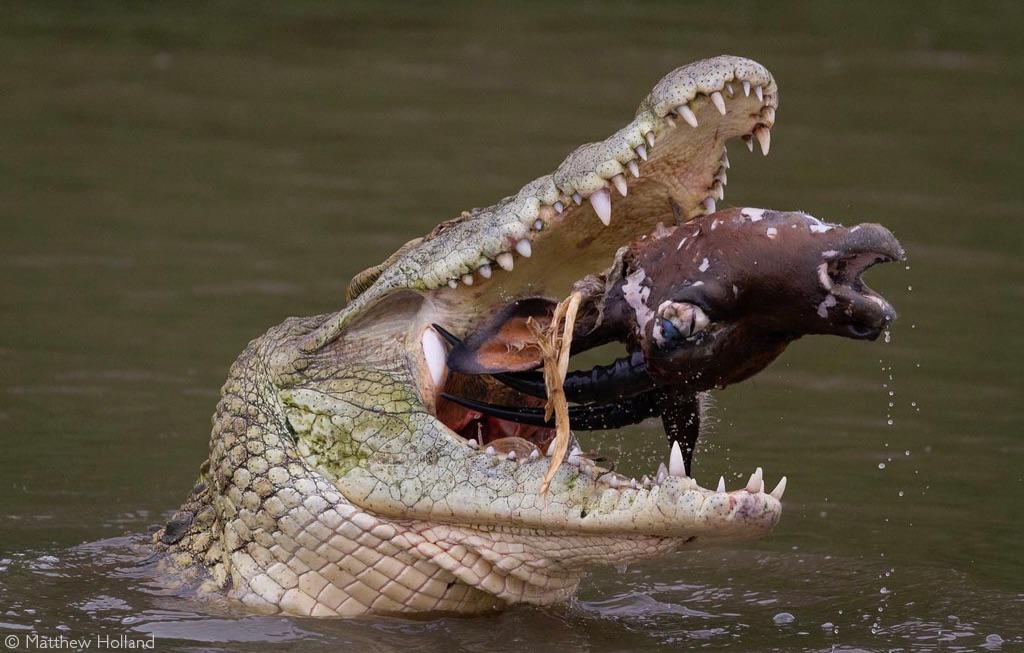
Despite their impressive adaptations, Nile crocodiles face numerous threats, including habitat destruction, pollution, and overfishing of their prey. As human activity continues to encroach on natural habitats, the delicate balance of these ecosystems is disrupted, often to the detriment of apex predators like crocodiles. Conservation efforts are essential in preserving both the habitats and the fish populations that sustain Nile crocodiles. Protecting river systems and controlling human-induced environmental changes will help ensure that crocodiles can continue to thrive as key players in their ecosystems.
Conclusion
The Nile crocodile’s fishing techniques highlight its evolutionary mastery of the aquatic environment. From ambush hunting to group coordination, these predators have developed a wide range of strategies to catch fish, making them one of the most successful hunters in Africa’s waterways. As we continue to study and conserve these remarkable animals, their fishing techniques offer a glimpse into the complex dynamics of the ecosystems they inhabit.
Tips for Understanding and Observing Nile Crocodile Fishing Techniques
Look for Ambush Spots:
Nile crocodiles often position themselves near riverbanks or submerged logs where fish swim by. If you’re observing in the wild, pay attention to areas with dense vegetation or shallow waters—these are prime ambush locations.
Observe Group Behavior:
During peak fish migration seasons or in areas with abundant fish, you may notice multiple crocodiles working together. Watch for coordinated movements where crocodiles seem to corral fish into smaller areas.
Early Morning and Late Afternoon:
Crocodiles are most active during cooler parts of the day. Early mornings and late afternoons are ideal times to observe their hunting behavior, especially surface snapping.
Check for Currents:
In rivers with strong currents or tidal flows, crocodiles take advantage of natural water movements to catch fish. Observing crocodiles in these locations might give insight into their strategy of using water flow to hunt with minimal effort.
Silent and Still Observation:
Crocodiles rely heavily on their ability to remain still while hunting. As a human observer, minimizing noise and movements will allow you to see their fishing strategies unfold without disturbing their natural behavior.
Document with Care:
If you’re photographing or documenting their fishing techniques, use zoom lenses or binoculars to maintain a safe distance. Nile crocodiles are apex predators and can be dangerous when disturbed.
Respect Conservation Areas:
Many habitats of the Nile crocodile are protected areas. Always follow guidelines set by wildlife reserves and conservation organizations to avoid disrupting the ecosystem or the crocodile’s natural behavior.
FAQs: Nile Crocodile Fishing Techniques
How do Nile crocodiles catch fish?
Nile crocodiles use a variety of techniques to catch fish, including ambush hunting, group coordination, surface snapping, and taking advantage of currents or tidal flows. They either remain still and wait for fish to come close or work together to trap fish in shallow areas.
Are Nile crocodiles solitary or group hunters when fishing?
While Nile crocodiles are often solitary hunters, they sometimes engage in group hunting, especially when there are large schools of fish. Group hunting allows them to corral fish into confined areas, increasing their chances of success.
What time of day are Nile crocodiles most active in fishing?
Nile crocodiles are most active during the cooler parts of the day, particularly early mornings and late afternoons. These times are ideal for observing their hunting and fishing behavior, as they tend to rest during the hottest part of the day.
How does a crocodile’s size affect its fishing technique?
Smaller, juvenile crocodiles tend to rely on simpler techniques like snapping at fish near the surface or chasing smaller prey. Larger, adult crocodiles are more likely to use advanced tactics such as ambush hunting or working cooperatively with others.
Do Nile crocodiles use their tails to catch fish?
Yes, Nile crocodiles use their powerful tails to swim quickly and maneuver through the water, especially when pursuing fish. Their tails also help them position themselves in currents, allowing fish to come to them naturally.
Can Nile crocodiles hunt fish in both fresh and saltwater?
While Nile crocodiles are primarily freshwater animals, they can tolerate brackish water. However, they mostly fish in freshwater rivers, lakes, and marshlands. Other crocodile species, like the Saltwater crocodile, are better adapted to saltwater environments.
How long can Nile crocodiles stay underwater while fishing?
Nile crocodiles can hold their breath underwater for up to an hour when necessary. This allows them to remain submerged while stalking fish or waiting for the perfect moment to strike.
Do crocodiles rely more on sight or other senses when fishing?
Crocodiles rely heavily on sight when the water is clear, but they also use their sense of smell and the ability to detect vibrations in murky waters. Their heightened senses allow them to hunt effectively even in low-visibility conditions.
Do Nile crocodiles compete with other animals for fish?
Yes, Nile crocodiles often share their habitat with other fish-eating predators, such as birds, hippos, and humans. Competition for fish can influence their hunting strategies and timing, especially in regions where resources are scarce.
How does water clarity affect a Nile crocodile’s hunting success?
Clearer water gives crocodiles a visual advantage, making it easier for them to spot and track fish. In murkier waters, they rely more on detecting vibrations and using ambush tactics to catch prey.
Contact Ushttps://crocogen.blog/
